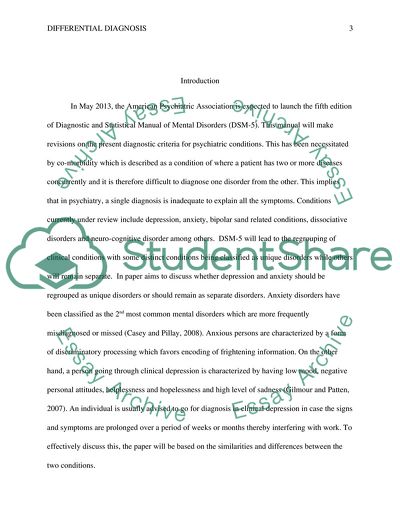Cite this document
(Evaluating the Case for Differential Diagnosis between Anxiety Coursework Example | Topics and Well Written Essays - 3000 words, n.d.)
Evaluating the Case for Differential Diagnosis between Anxiety Coursework Example | Topics and Well Written Essays - 3000 words. https://studentshare.org/psychology/1770701-evaluating-the-case-for-differential-diagnosiscritically-evaluate-the-characteristics-of-two-overlapping-clinical-conditions-justifying-whether-they-should-be-considered-separate-or-unique-disorders-in-the-next-dsm
Evaluating the Case for Differential Diagnosis between Anxiety Coursework Example | Topics and Well Written Essays - 3000 words. https://studentshare.org/psychology/1770701-evaluating-the-case-for-differential-diagnosiscritically-evaluate-the-characteristics-of-two-overlapping-clinical-conditions-justifying-whether-they-should-be-considered-separate-or-unique-disorders-in-the-next-dsm
(Evaluating the Case for Differential Diagnosis Between Anxiety Coursework Example | Topics and Well Written Essays - 3000 Words)
Evaluating the Case for Differential Diagnosis Between Anxiety Coursework Example | Topics and Well Written Essays - 3000 Words. https://studentshare.org/psychology/1770701-evaluating-the-case-for-differential-diagnosiscritically-evaluate-the-characteristics-of-two-overlapping-clinical-conditions-justifying-whether-they-should-be-considered-separate-or-unique-disorders-in-the-next-dsm.
Evaluating the Case for Differential Diagnosis Between Anxiety Coursework Example | Topics and Well Written Essays - 3000 Words. https://studentshare.org/psychology/1770701-evaluating-the-case-for-differential-diagnosiscritically-evaluate-the-characteristics-of-two-overlapping-clinical-conditions-justifying-whether-they-should-be-considered-separate-or-unique-disorders-in-the-next-dsm.
“Evaluating the Case for Differential Diagnosis Between Anxiety Coursework Example | Topics and Well Written Essays - 3000 Words”. https://studentshare.org/psychology/1770701-evaluating-the-case-for-differential-diagnosiscritically-evaluate-the-characteristics-of-two-overlapping-clinical-conditions-justifying-whether-they-should-be-considered-separate-or-unique-disorders-in-the-next-dsm.


